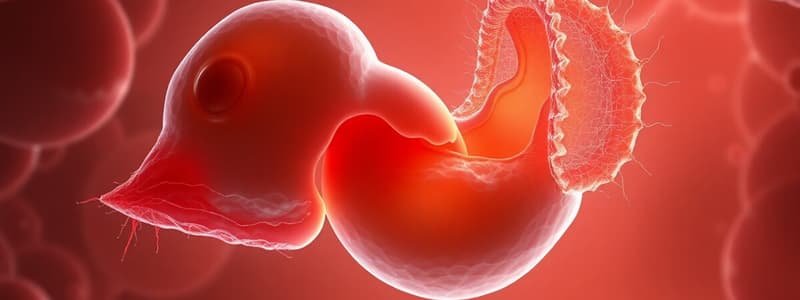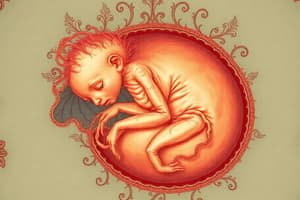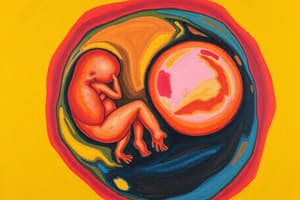Podcast
Questions and Answers
What structure is formed by the auricular hillocks during the development of the external ear?
What structure is formed by the auricular hillocks during the development of the external ear?
- Tympanic membrane
- Auricle (pinna) (correct)
- Eustachian tube
- Auditory meatus
Which event occurs due to the abdominal cavity being too small during early development?
Which event occurs due to the abdominal cavity being too small during early development?
- Cervical curvature
- Umbilical herniation (correct)
- Ossification of limbs
- Neck straightening
What significant change occurs in the embryo by the end of the fourth week regarding organ systems?
What significant change occurs in the embryo by the end of the fourth week regarding organ systems?
- The urogenital system is completely formed.
- Only the limbs are fully developed.
- Foundations of most major organ systems are established. (correct)
- Most organ systems are fully developed.
Which change is observed in limb development during the seventh week of embryonic development?
Which change is observed in limb development during the seventh week of embryonic development?
Which structures become visible as surface elevations in the embryo during the fourth week?
Which structures become visible as surface elevations in the embryo during the fourth week?
What occurs at the end of the eighth week concerning the limbs?
What occurs at the end of the eighth week concerning the limbs?
Which arch contributes to the formation of both the lower and upper jaw?
Which arch contributes to the formation of both the lower and upper jaw?
What significant skeletal change begins by the end of the seventh week?
What significant skeletal change begins by the end of the seventh week?
What defines the C-shaped appearance of the embryo by mid-week?
What defines the C-shaped appearance of the embryo by mid-week?
Which aspect of development is primarily addressed by the term 'induction'?
Which aspect of development is primarily addressed by the term 'induction'?
During the fourth week of embryonic development, what happens to the cranial neuropore?
During the fourth week of embryonic development, what happens to the cranial neuropore?
Which development reflects significant vascular changes during the eighth week?
Which development reflects significant vascular changes during the eighth week?
What movement occurs for the first time during the eighth week of development?
What movement occurs for the first time during the eighth week of development?
What is a primary effect of tissue interactions during embryonic development?
What is a primary effect of tissue interactions during embryonic development?
What distinct human characteristic is visible by the end of the eighth week?
What distinct human characteristic is visible by the end of the eighth week?
What role does programmed cell death (apoptosis) play in embryonic development?
What role does programmed cell death (apoptosis) play in embryonic development?
Which statement accurately describes the development of organ system rudiments during the fourth week?
Which statement accurately describes the development of organ system rudiments during the fourth week?
How does head growth compare to other body regions during the fifth week of development?
How does head growth compare to other body regions during the fifth week of development?
What characterizes the differentiation of upper limbs during the sixth week?
What characterizes the differentiation of upper limbs during the sixth week?
What is observed in embryos regarding spontaneous movements during the sixth week?
What is observed in embryos regarding spontaneous movements during the sixth week?
Which feature indicates the proximity of the face to the heart during the fifth week?
Which feature indicates the proximity of the face to the heart during the fifth week?
What are auricular hillocks associated with in the sixth week of development?
What are auricular hillocks associated with in the sixth week of development?
What developmental stage occurs earlier for the upper limbs compared to the lower limbs?
What developmental stage occurs earlier for the upper limbs compared to the lower limbs?
How do the mesonephric ridges contribute during the fifth week?
How do the mesonephric ridges contribute during the fifth week?
Flashcards are hidden until you start studying
Study Notes
Embryonic Development: Week 4
- Embryo is C-shaped, approximately 4 mm in length
- Somites (blocks of mesoderm) appear along the sides of the neural tube
- Head is rudimentary with developing eyes, ears, and a partially broken oropharyngeal membrane
- Pharyngeal arches are prominent in the neck region
- Heart and liver create bulges on the ventral body wall
- Body stalk and spiraled tail are visible
- Rudiments of many organ systems, especially the cardiovascular system, are established
Embryonic Development: Week 4: Detailed Changes
- Somite Formation: Embryonic somites increase from 4 to 12, visible as surface elevations
- Pharyngeal Arches:
- First pharyngeal arch (mandibular arch) appears, contributing to the lower and upper jaw
- Three pairs of pharyngeal arches are visible, with the cranial neuropore closing
- Embryo Curvature: Embryo curves due to head and tail folds, becoming C-shaped by mid-week
- Heart Development: Heart becomes prominent, pumps blood
- Limb Buds: Upper limb buds appear, followed by lower limb buds
- Sensory Organ Primordia: Otic pits (precursors to the internal ears) and lens placodes (precursors to the eyes) become visible
- Tail Formation: A prominent tail-like caudal eminence develops
- Caudal Neuropore Closure: The caudal neuropore typically closes by the end of the fourth week
Embryonic Development: Week 5
- Head growth surpasses other body regions due to brain and facial prominence development
- Face moves closer to the heart prominence
- Second pharyngeal arch overgrows others, creating a lateral depression (cervical sinus)
- Mesonephric ridges become visible, marking the developing mesonephric kidneys
Embryonic Development: Week 6
- Embryos exhibit spontaneous movements, such as trunk twitching and limb movements
- Upper limbs show regional differentiation, developing elbows and hand plates
- Primordia of digits (fingers) form in the hands
- Lower limb development begins
- Auricular hillocks develop around the pharyngeal groove
Embryonic Development: Week 7
- Limbs undergo considerable change, with notches appearing between the digital rays in the hands and feet, indicating digit formation
- Communication between the primordial gut and umbilical vesicle is reduced, with the yolk stalk transforming into the omphaloenteric duct
- Ossification begins in the bones of the upper limbs
Embryonic Development: Week 8
- Hand digits are separated but initially webbed, becoming fully separated by the end of the week
- Foot digital rays are also clearly visible
- The caudal eminence becomes stubby and disappears
- Scalp vascular plexus forms a band around the head
- Purposeful limb movements begin
- Primary ossification starts in the femora (thigh bones)
- Embryo exhibits distinct human characteristics, with a neck established and visible eyelids that begin to close
Development Mechanisms
- Tissue interactions, regulated cell migration, controlled cell proliferation, and programmed cell death (apoptosis) are involved
- Growth occurs through cell division (mitosis) and production of extracellular matrices
- Complexity arises through morphogenesis (shaping of organs and tissues) and differentiation (specialization of cells)
- Inductions (interactions between different tissues) play a vital role, ensuring the synchronized development of tissues and organs. For example, the optic vesicle induces lens formation from the surface ectoderm
- Inductive processes often occur sequentially, ensuring orderly development of complex structures
- Some interactions are reciprocal, with each tissue influencing the other’s development
Further Development
- Groove between the auricular hillocks forms the external ear canal
- Auricular hillocks contribute to forming the auricle (pinna)
- Eyes become more prominent due to retinal pigment formation
- Head grows larger relative to the trunk, bending over the heart prominence due to bending in the cervical (neck) region. The trunk and neck begin to straighten
- Intestines enter the extraembryonic coelom in the proximal part of the umbilical cord (umbilical herniation) because the abdominal cavity cannot accommodate their rapid growth
Studying That Suits You
Use AI to generate personalized quizzes and flashcards to suit your learning preferences.




